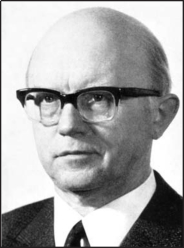- LUDWIEG
- GERMANY (see also List of Individuals)\
 9.10.1912 Parensen/D - 12.2.2001 Göttingen/D\Hubert Ludwieg graduated as a mathematician from the University of Göttingen in 1938 and submitted there his PhD thesis in 1939, in collaboration with Ludwig Prandtl (1875-1953). He was until 1955 a collaborator of Aerodynamische Versuchsanstalt AVA, Göttingen until being appointed at University of Göttingen Lecturer first, and from 1962 associate professor; he lectured on the wing theory, boundary layers and fluid machinery. Once the German aviation institutions AVA and DFL had merged to Deutsche Forschungs-Vereinigung für Luftund Raumfahrt DFVLR in 1969, Ludwieg was appointed director of the gas dynamics group and directed from 1972 its Institute of Fluid Mechanics.\Ludwieg proposed a probe to measure wall shear stresses in turbulent flow as a standard instrumentation for decades. He is known for a research work in collaboration with Tillmann in 1949. The surface shear stress with a pressure gradient was investigated close to walls, which may be described with a laminar sublayer and a turbulent wall zone in which the universal wall law applies as for flat plates. In the 1950's Ludwieg continued research in turbulent boundary layers by determining the eddy viscosity for heat flow. The Ludwieg Tube allows generating constant flow conditions at high Reynolds numbers. He investigated extensively the stability of spiral flows associated with vortex break-up. Ludwieg was awarded the Ludwig Prandtl Ring in 1990.\Anonymous (1977). Beiträge zur experimentellen Strömungsmechanik: Hubert Ludwieg zum65. Geburtstag. DFVLR: Göttingen.Ludwieg, H. (1939). Über Potentialströmungen mit unstetigen Randbedingungen. Dissertation.Universität: Göttingen.Ludwieg, H. (1949). Ein Gerät zur Messung der Wandschubspannungen turbulenter Reibungsschichten. Ingenieur-Archiv 17: 207-218.Ludwieg, H., Tillmann, W. (1949). Untersuchung über die Wandschubspannung in turbulenten Reibungsschichten. Ingenieur-Archiv 17: 288-299.Ludwieg, H. (1956). Bestimmung des Verhältnisses des Austauschkoeffizienten für Wärme und Impuls bei turbulenten Grenzschichten. Zeitschrift für Flugwissenschaften 4(1/2): 73-81. Ludwieg, H. (1969). Forschungsarbeiten der Abteilung Gasdynamik seit 1945. Die Aerodynamische Versuchsanstalt Göttingen 1945-1969: 63-89. AVA: Göttingen. PPoggendorff, J.C. (1953). Ludwieg, Hubert. Biographisch-Literarisches Handwörterbuch7a: 145. Akademie Verlag: Berlin, with bibliography.
9.10.1912 Parensen/D - 12.2.2001 Göttingen/D\Hubert Ludwieg graduated as a mathematician from the University of Göttingen in 1938 and submitted there his PhD thesis in 1939, in collaboration with Ludwig Prandtl (1875-1953). He was until 1955 a collaborator of Aerodynamische Versuchsanstalt AVA, Göttingen until being appointed at University of Göttingen Lecturer first, and from 1962 associate professor; he lectured on the wing theory, boundary layers and fluid machinery. Once the German aviation institutions AVA and DFL had merged to Deutsche Forschungs-Vereinigung für Luftund Raumfahrt DFVLR in 1969, Ludwieg was appointed director of the gas dynamics group and directed from 1972 its Institute of Fluid Mechanics.\Ludwieg proposed a probe to measure wall shear stresses in turbulent flow as a standard instrumentation for decades. He is known for a research work in collaboration with Tillmann in 1949. The surface shear stress with a pressure gradient was investigated close to walls, which may be described with a laminar sublayer and a turbulent wall zone in which the universal wall law applies as for flat plates. In the 1950's Ludwieg continued research in turbulent boundary layers by determining the eddy viscosity for heat flow. The Ludwieg Tube allows generating constant flow conditions at high Reynolds numbers. He investigated extensively the stability of spiral flows associated with vortex break-up. Ludwieg was awarded the Ludwig Prandtl Ring in 1990.\Anonymous (1977). Beiträge zur experimentellen Strömungsmechanik: Hubert Ludwieg zum65. Geburtstag. DFVLR: Göttingen.Ludwieg, H. (1939). Über Potentialströmungen mit unstetigen Randbedingungen. Dissertation.Universität: Göttingen.Ludwieg, H. (1949). Ein Gerät zur Messung der Wandschubspannungen turbulenter Reibungsschichten. Ingenieur-Archiv 17: 207-218.Ludwieg, H., Tillmann, W. (1949). Untersuchung über die Wandschubspannung in turbulenten Reibungsschichten. Ingenieur-Archiv 17: 288-299.Ludwieg, H. (1956). Bestimmung des Verhältnisses des Austauschkoeffizienten für Wärme und Impuls bei turbulenten Grenzschichten. Zeitschrift für Flugwissenschaften 4(1/2): 73-81. Ludwieg, H. (1969). Forschungsarbeiten der Abteilung Gasdynamik seit 1945. Die Aerodynamische Versuchsanstalt Göttingen 1945-1969: 63-89. AVA: Göttingen. PPoggendorff, J.C. (1953). Ludwieg, Hubert. Biographisch-Literarisches Handwörterbuch7a: 145. Akademie Verlag: Berlin, with bibliography.
Hydraulicians in Europe 1800-2000 . 2013.
